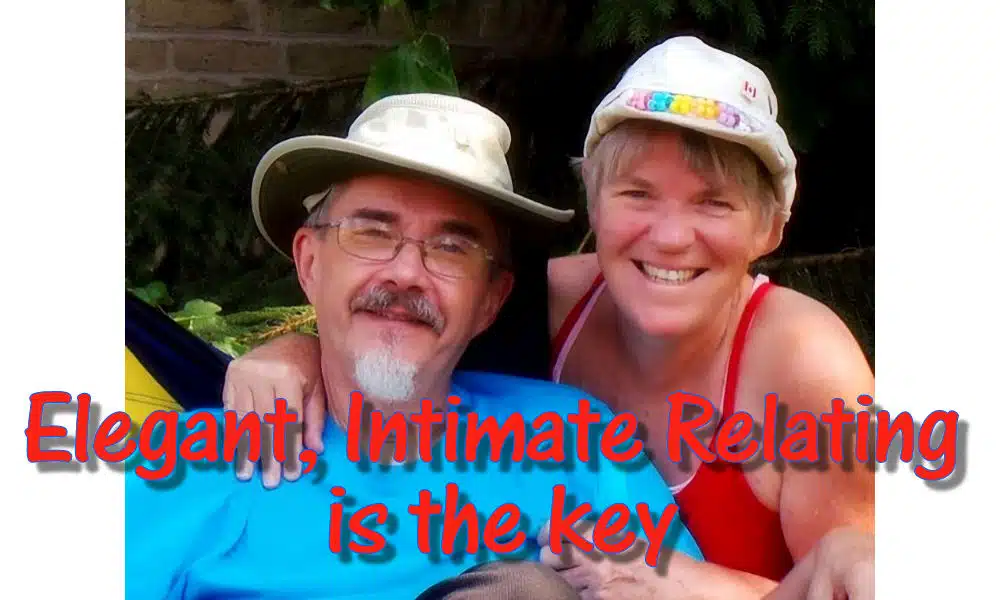Synopsis: Elegant, Intimate Relating is the structure behind excellent partnerships.

Want to learn more about living a full and meaningful life?
Want to have the best relationship ever?
Check out my books

Steps for Elegant, Intimate Relating
Last article, I made a comment or two about relating, and mentioned that this time I’d explore communication. Then, I thought, it might be fun to share with you the ground floor for building a creative and functioning relationship.
As it turns out, I wrote a book about this not so long ago, so I decided to share a chapter with you, entitled, Elegant, Intimate Relating (EIR). Taken from my book, The. Best. Relationship. Ever., which is available as a paperback and as an e‑book from online booksellers.
EIR is a structure for living deeply and fully with others
With EIR, nothing is taken for granted. Elegant, Intimate Relating requires the active participation of two separate and distinct beings, both of whom are dedicated to rigorous self-exploration. Each is using the relationship to gain depth and breadth of knowledge about the only thing each can know: themselves.
Elegant, Intimate Relating is enacted at the direct meeting of two whole persons. I call this “meeting at the boundary” – I am still I, you are still you, and we meet to explore, to reveal, to be open and vulnerable through honest revelation.
The revelation has to be authentic
In EIR, you are choosing to be transparent with your partner.
EIR is not about saying nice things, not about manipulating your partner to see or do things your way. Nor is it about hiding the fact that you have a range of feelings and emotions “in there.” Transparent authenticity is choosing to let yourself be seen – as you are, and how you are.
Elegant, Intimate Relating happens only in the Here and Now
It’s about true vulnerability. Vulnerability happens as I choose to reveal my internal experience and intentions, as opposed to using them as a basis for manipulation.
Vulnerability is expressed by letting out what is going on for you, right now, with no excuses. This is me, right now. And part of “me, right now,” is the emotion that is happening inside of me. Not descriptions of the emotions, not blaming someone for the emotions, but rather the emotions themselves.
Once you “get this,” you’ll also notice that emotions are fleeting. I can be sad, then bored, then weepy, then laugh-filled, then have the feeling of “nothing much,” but only if I do not cling to my story, a.k.a. thinking too much.

Being unguarded
Un-guarding yourself means being willing to own and share your in-the-moment reality, without filtering. Being un-guarded means speaking your truth – the truth that comes from “Here is what is so for me…”
The point of Elegant, Intimate Relating is to clear the decks so that you can shift what is not working. Letting go of guardedness gives us the opportunity to see how we are structuring our stories to stay stuck.
From there, you choose to do something new and refreshing. It’s not meant as an exercise in self-aggrandizement, and emphatically is not a game to stay stuck, while pretending to “get it.”
Un-guarding means loosening the filters, and expressing yourself as you are, with focus and clarity.
The Beginning of Elegant, Intimate Relating
The Tools section of the book describes the “how” of an EIR. Here’s the “what.” The following is from my book, The. Best. Relationship. Ever.
Engaged Intimacy, first of all, requires a dialogue agreement
Let me whip out my crystal ball and declare that your past relationship failures were caused by poor, faulty, or non-existent verbal communication. Other problems were: non-verbal communication, magical thinking, lack of physical intimacy, and lack of self-responsibility.We are going to establish a dialogue agreement, and then discuss how to enact it.
The Dialogue Agreement
“I have decided to commit myself to open, honest, and vulnerable communication. I will use a Communication Model, self-responsible language, and will keep my boundaries open and flexible. I will be in dialogue with you for no less than 30 minutes per day, and when issues cannot be resolved within that time-frame, I agree to make as much time as necessary to resolve the issue, with no compromise. I commit to keep you totally informed about what is going on for me: my stories, my games, my evasions. I will keep you completely informed about my feelings, my attractions, and my other relationships. I do so not for permission, but to facilitate clarity.”
The Physical Contact Agreement
Given that we’re discussing your Primary Relationship, physical contact is a given. We’ve noted that Engaged Intimacy is also available for other relationships. I think it’s important to establish physical parameters, even within the Primary Relationship. Thus:
“I commit to using physical contact as another way of exploring my emotions, blockages, and my connection with you. I accept that physical contact is an end unto itself – that it is not primarily a means to having sex. I will be open and honest about my need for emotional expression, and will use safe methods of expressing my emotions thoroughly. I will ask for what I want as regards physical contact, recognizing that what I want “now,” may not be what I want “later.” I am open to expressing whatever feelings arise through physical contact, will stay focussed on myself, and will feel my feelings fully.”
This becomes the framework for Engaged Intimacy
From this baseline, which you are free to add to, but not reduce, we begin the process of building intimacy and presence.
I would suggest that you look carefully at the above Agreements, and then read through the “Tools” chapters to follow. Once you have a grasp on how this all fits together, sit with your partner, begin right here with the Agreements, and structure your own agreements.
You will want to write out what you are agreeing to, and then sign it. Remember: all you can agree to is what you will do. This is not a conditional, “If you do this, then I’ll do that” kind of agreement. You are making the commitment to yourself to act in a certain way, while in your partner’s presence. I’ll be reminding you of that as we go along.
